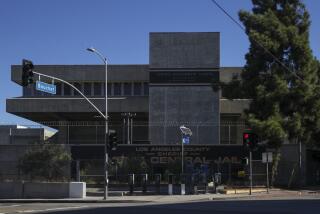King’s Facial Injuries Laid to Baton Blows
- Share via
Rodney G. King’s swollen face peered out at jurors from blowup photos Thursday as a medical expert testified that King’s facial bones were shattered by police batons, not by a fall to an asphalt road.
“The pattern of injuries . . . are consistent with a focal but blunt instrument, a baton or baton-like instrument,” said Dr. Harry Lincoln Smith, a biomechanics expert who used skull models to give jurors a short course in anatomy as he testified for the government in the trial of four policemen.
“Are Mr. King’s injuries consistent with a fall to the ground?” asked Assistant U.S. Atty.Steven Clymer.
“No, they are not,” Smith told the federal court jury.
Smith isolated for the first time a split second in the blurry opening portion of the famous beating videotape, which he said shows Officer Laurence M. Powell beating a fallen King directly on the head and face.
“Although it is very blurry,” said Smith, “it is to me apparent that as Mr. King is down, Officer Powell does the striking moves to the head and is then swinging multiple times. That gives multiple opportunities for Mr. King to be struck in the head and face.”
He said the first blow to King seen clearly on the videotape as King is standing also was struck by Powell to the head.
Powell’s lawyer has maintained that his client never struck King on the head--which is forbidden by police policy unless deadly force is required. A central defense is that King’s cheekbone and eye socket were smashed when he fell to the ground while fighting officers.
No prosecution experts other than King’s treating physicians testified at the officers’ previous trial in state court.
Smith’s statements supported testimony Tuesday by Dr. Charles Aronberg, chief of ophthalmology at Cedars-Sinai Medical Center, who said it is his opinion that King’s injuries were caused by baton blows to the head and face and not by a fall to the pavement.
Powell is charged along with Officers Timothy E. Wind and Theodore J. Briseno and Sgt. Stacey C. Koon with violating King’s federal civil rights in the March 3, 1991, beating which was videotaped by an amateur cameraman.
Acquittals in the state trial set off riots in Los Angeles. Federal prosecutors trying the officers on new charges have relied on many new witnesses, including Smith and King himself.
Smith, of San Antonio, Tex., said that if King fell hard enough to break bones, he would have also had a broken nose, ear injuries, facial abrasions and skin “tattooing” from grit and pebbles on the ground.
“We don’t see that in any way,” said Smith. “If a fall were to be considered, I would see the skin abraded and tattooed from making contact in some major fashion with a rough asphalt or concrete surface.”
Meanwhile, King’s dramatic testimony earlier this week continued to reverberate in the trial. As Thursday’s session began, defense attorney Harland Braun angrily asked that large portions of King’s testimony about racial comments be stricken and that the jury be told to forget it.
U.S. District Judge John G. Davies refused.
Braun accused prosecutors of misconduct for not warning the defense that King would waffle on his allegation that officers shouted the word “nigger” as he was being beaten.
“I can’t think of anything in this case that was more serious, more prejudicial to the defendants and more serious to the community at large,” Braun said.
King testified that at some point during his beating, he heard a chant from policemen using the words “killer” and “nigger.” But on further questioning, he said he wasn’t sure that the racial epithet was used.
Clymer denounced the defense motion as frivolous and despicable.
“What Mr. Braun really wanted was to hide the truth from the jury . . . Mr. Braun doesn’t like that testimony,” said Clymer.
The judge said the defense should have objected when King was on the stand but indicated the government had no obligation to inform the defense of “a slight change” in testimony the defense already knew about.
“I see no misconduct, absolutely none,” the judge said. “The government turned over all of Mr. King’s statements in a timely fashion. Mr. King was impeached on that issue. I really can’t see how the defendants can complain.”
Davies suggested that defense lawyers adequately challenged King by accusing him of injecting race into the case to help his $50-million civil suit against the city.
“You were given (earlier King) statements where epithets were absent,” Davies said. “A lawsuit was filed in this court . . . and after the lawsuit was filed, the epithets emerged.”
More to Read
Sign up for Essential California
The most important California stories and recommendations in your inbox every morning.
You may occasionally receive promotional content from the Los Angeles Times.













